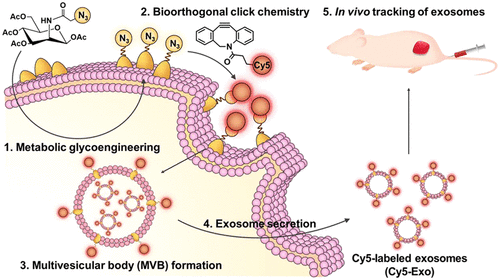当前位置:
X-MOL 学术
›
Bioconjugate Chem.
›
论文详情
Our official English website, www.x-mol.net, welcomes your
feedback! (Note: you will need to create a separate account there.)
In Situ One-Step Fluorescence Labeling Strategy of Exosomes via Bioorthogonal Click Chemistry for Real-Time Exosome Tracking In Vitro and In Vivo.
Bioconjugate Chemistry ( IF 4.0 ) Pub Date : 2020-05-11 , DOI: 10.1021/acs.bioconjchem.0c00216 Sukyung Song 1, 2 , Man Kyu Shim 1 , Seungho Lim 1 , Yujeong Moon 1, 3 , Suah Yang 1, 4 , Jinseong Kim 1, 4 , Yeonsun Hong 1 , Hong Yeol Yoon 1 , In-San Kim 1, 4 , Kwang Yeon Hwang 2 , Kwangmeyung Kim 1, 4
Bioconjugate Chemistry ( IF 4.0 ) Pub Date : 2020-05-11 , DOI: 10.1021/acs.bioconjchem.0c00216 Sukyung Song 1, 2 , Man Kyu Shim 1 , Seungho Lim 1 , Yujeong Moon 1, 3 , Suah Yang 1, 4 , Jinseong Kim 1, 4 , Yeonsun Hong 1 , Hong Yeol Yoon 1 , In-San Kim 1, 4 , Kwang Yeon Hwang 2 , Kwangmeyung Kim 1, 4
Affiliation

|
Exosomes are cellular components with promising uses in cancer diagnostics and therapeutics, and their imaging and tracking are essential to study their biological properties. Herein, we report on an in situ one-step fluorescence labeling strategy for exosomes via bioorthogonal click chemistry. First, exosome donor cancer cells were treated with tetraacetylated N-azidoacetyl-d-mannosamine (Ac4ManNAz) to generate unnatural azide groups (-N3) on their surface via metabolic glycoengineering. Then, the azide groups were labeled with near-infrared fluorescent dye-conjugated dibenzylcyclooctyne (DBCO-Cy5) via bioorthogonal click chemistry. After 2 days of incubation, the DBCO-Cy5-labeled exosomes (Cy5-Exo) were successfully secreted from the donor cancer cells and were isolated via classical ultracentrifugation, providing a high-yield of fluorescent dye-labeled exosomes. This in situ one-step bioorthogonal click chemistry offers improved labeling efficiency, biocompatibility, and imaging sensitivy compared to standard exosomes (ST-Exo), purified with classical ultracentrifugation or carbocyanine lipophilic dye (DiD)-labeled exosomes (DiD-Exo) in vitro. In particular, the Cy5-Exo were successfully taken up by A549 cells in a time-dependent manner, and they could escape from lysosome confinement, showing their possible use as a delivery carrier of therapeutic drugs or imaging agents. Finally, intraveneously injected Cy5-Exo were noninvasively tracked and imaged via near-infrared fluorescence (NIRF) imaging in tumor-bearing mice. This new fluorescence labeling strategy for natural exosomes may be useful to provide better understanding of their theranostic effects in many biomedical applications.
中文翻译:

通过生物正交点击化学对外泌体进行原位一步荧光标记策略,用于体内和体外实时跟踪。
外来体是在癌症诊断和治疗中有前景的细胞成分,它们的成像和追踪对于研究其生物学特性至关重要。在这里,我们报告通过生物正交点击化学外泌体的原位一步荧光标记策略。首先,用四乙酰化N-叠氮基乙酰基-d-甘露糖胺(Ac4ManNAz)处理外泌体供体癌细胞,以通过代谢糖工程在其表面上生成非天然叠氮基团(-N3)。然后,叠氮化物基团通过生物正交点击化学用近红外荧光染料偶联的二苄基环辛炔(DBCO-Cy5)标记。孵育2天后,成功地从供体癌细胞中分泌了DBCO-Cy5标记的外泌体(Cy5-Exo),并通过经典的超速离心方法进行了分离,提供高产量的荧光染料标记的外来体。与标准外泌体(ST-Exo)相比,这种经典的一步一步生物正交点击化学可提供更高的标记效率,生物相容性和成像灵敏度,并采用经典的超速离心法或经花青素亲脂性染料(DiD)标记的外泌体(DiD-Exo)体外纯化。特别地,Cy5-Exo成功地以时间依赖性方式被A549细胞吸收,并且它们可以脱离溶酶体的限制,显示出它们可能用作治疗药物或成像剂的递送载体。最后,在荷瘤小鼠中无创跟踪静脉注射Cy5-Exo并通过近红外荧光(NIRF)成像。
更新日期:2020-05-05
中文翻译:

通过生物正交点击化学对外泌体进行原位一步荧光标记策略,用于体内和体外实时跟踪。
外来体是在癌症诊断和治疗中有前景的细胞成分,它们的成像和追踪对于研究其生物学特性至关重要。在这里,我们报告通过生物正交点击化学外泌体的原位一步荧光标记策略。首先,用四乙酰化N-叠氮基乙酰基-d-甘露糖胺(Ac4ManNAz)处理外泌体供体癌细胞,以通过代谢糖工程在其表面上生成非天然叠氮基团(-N3)。然后,叠氮化物基团通过生物正交点击化学用近红外荧光染料偶联的二苄基环辛炔(DBCO-Cy5)标记。孵育2天后,成功地从供体癌细胞中分泌了DBCO-Cy5标记的外泌体(Cy5-Exo),并通过经典的超速离心方法进行了分离,提供高产量的荧光染料标记的外来体。与标准外泌体(ST-Exo)相比,这种经典的一步一步生物正交点击化学可提供更高的标记效率,生物相容性和成像灵敏度,并采用经典的超速离心法或经花青素亲脂性染料(DiD)标记的外泌体(DiD-Exo)体外纯化。特别地,Cy5-Exo成功地以时间依赖性方式被A549细胞吸收,并且它们可以脱离溶酶体的限制,显示出它们可能用作治疗药物或成像剂的递送载体。最后,在荷瘤小鼠中无创跟踪静脉注射Cy5-Exo并通过近红外荧光(NIRF)成像。











































 京公网安备 11010802027423号
京公网安备 11010802027423号